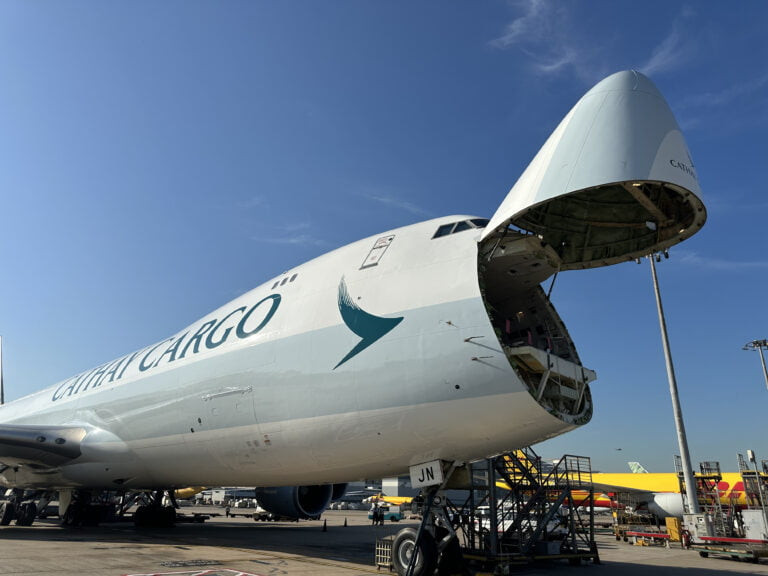Returning to around 85 percent of pre-Covid levels, Cathay Cargo now flies to 15 cities in the Chinese Mainland, including freighters to key manufacturing hubs, namely Zhengzhou, Chengdu, Chongqing, Shanghai and Xiamen. Cathay’s subsidiary and regional cargo arm, Air Hong Kong, also serves Beijing with its fleet of 16 freighters, on top of the five cities served by Cathay Cargo.
With its performance so far, Cathay Cargo is confident that 2024 will be a good year for air cargo, led by e-commerce, a large amount of which is sourced from the southern part of the Chinese Mainland, so Hong Kong and Cathay Cargo are ideally placed to serve the industry.
“Our Cathay Group currently flies to over 80 passenger destinations around the world, and is about to reach 90 by 2025. This includes 19 airports in 17 cities on the Chinese mainland,” James Evans, Cathay Cargo’s General Manager Commercial, stated.
“As a Group, we have restored our passenger flights to more than 80 percent percent of pre-pandemic levels, and we are now working towards reaching 100 percent within the first quarter of 2025. We will continue to evaluate our network and strategically redeploy our capacity to destinations that may offer greater growth potential, including destinations in the Chinese Mainland and along the Central Government’s Belt and Road Initiative.
“Our focus continues to be rebuilding in a measured and responsible manner as the airlines look ahead to the exciting opportunities presented by the upcoming Three-Runway System at Hong Kong International Airport (HKIA).
Intermodal interest
Alongside its rebound post-pandemic, Cathay Cargo has strengthened intermodal links with its extended home market in the Greater Bay Area (GBA), which is home to approximately 86 million people. Now imports have commenced between Hong Kong International Airport (HKIA) and the new Cathay Cargo Terminal in Dongguan, commercial import shipments head by boat directly from the airport, entering this giant market.
The development of intermodal activities – cross-border trucking, the Dongguan sea-to-air development, and on the passenger side, the expansion of the carrier’s lounge network to include ferry facilities in the Greater Bay Area – are intended not simply to target e-commerce but instead to expand the interconnectivity of Hong Kong with the rest of the Greater Bay Area.
The trade connections between these two markets are very obvious and have certainly been boosted by e-commerce, but the goal is to make sure that Hong Kong is well-positioned in the future to support the exceptional opportunities that the GBA offers.
“The commencement of northbound ferry operations at the HKIA Logistics Park in Dongguan will complement Cathay Cargo’s upstream intermodal air cargo service between HKIA and the Dongguan facility on the Chinese Mainland,” Evans highlighted.
“Together with the already-successfully running southbound sailings, security-screened and palletised air cargo shipments northbound will help customers avoid potential land border delays.
“The seamless service further enables Cathay Cargo to be the world’s most customer-centric air cargo service brand and helps improve the efficiency of imports to its extended home market in the GBA.”
Green initiative
Cathay continues to make important strides towards establishing itself as a sustainability leader. Through the ‘Greener Together’ approach, it endeavours to cultivate stronger collaboration with important stakeholders to decarbonise the aviation industry and achieve its goal of net-zero carbon emissions by 2050.
Grace Cheung, Cathay’s General Manager of Sustainability said: “This year, Cathay set a new near-term target to improve our carbon intensity by 12 percent from the 2019 level by 2030. Accelerating the use of Sustainable Aviation Fuel (SAF) remains the most important lever for achieving the new target and net-zero operations in the long run.
Cathay has undertaken a multi-pronged approach to forge strategic partnerships with like-minded organisations and stakeholders along the SAF value chain. This includes the introduction of Asia’s first major corporate SAF programme for corporate customers to make use of SAF in reducing their aviation-related indirect emissions as well as the co-initiating of the launch of the Hong Kong Sustainable Aviation Fuel Coalition earlier this year.
Taking one step further to scale up SAF usage on all fronts, Cathay will use SAF to offset 10 percent of the carbon emissions from employee duty travel on Cathay Pacific flights. These are in line with our pioneering position in accelerating the development and deployment of SAF in the region and, more importantly, contributing to our 10 percent SAF usage by 2030 goal.”




